
A boat is a watercraft of a large range of types and sizes, but generally smaller than a ship, which is distinguished by its larger size, shape, cargo or passenger capacity, or its ability to carry boats.
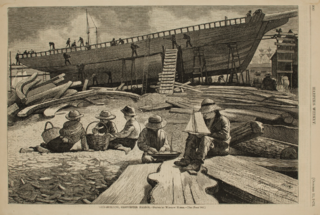
Shipbuilding is the construction of ships and other floating vessels. It normally takes place in a specialized facility known as a shipyard. Shipbuilders, also called shipwrights, follow a specialized occupation that traces its roots to before recorded history.

A mortiseand tenon joint connects two pieces of wood or other material. Woodworkers around the world have used it for thousands of years to join pieces of wood, mainly when the adjoining pieces connect at right angles.

A cog was a type of ship that was used during the Middle Ages, mostly for trade and transport but also in war. It first appeared in the 10th century, and was widely used from around the 12th century on. Cogs were clinker-built, generally of oak. Cogs were fitted with a single mast and a single square sail. They were used primarily for trade in north-west medieval Europe, especially by the Hanseatic League. Typical seagoing cogs were from 15 to 25 meters long, 5 to 8 meters wide, and were of 30–200 tons burthen. Cogs were rarely as large as 300 tons although a few were considerably larger, over 1,000 tons.
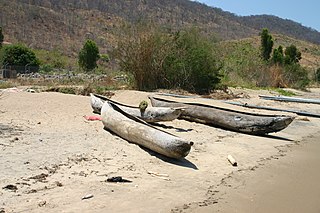
A dugout canoe or simply dugout is a boat made from a hollowed-out tree. Other names for this type of boat are logboat and monoxylon. Monoxylon (μονόξυλον) is Greek – mono- (single) + ξύλον xylon (tree) – and is mostly used in classic Greek texts. In German, they are called Einbaum. Some, but not all, pirogues are also constructed in this manner.

Carvel built or carvel planking is a method of boat building in which hull planks are laid edge to edge and fastened to a robust frame, thereby forming a smooth surface. Traditionally the planks are neither attached to, nor slotted into, each other, having only a caulking sealant between the planks to keep water out. Modern carvel builders may attach the planks to each other with glues and fixings. It is a "frame first" method of hull construction, where the shape is determined by the framework onto which the planks are fixed. This is in contrast to "plank first" or "shell first" methods, where the outer skin of the hull is made and then reinforced by the insertion of timbers that are fitted to that shape. The most common modern "plank first" method is clinker construction; in the classical period "plank first" involved joining the edges of planks with mortise and tenon joints within the thickness of the timbers, superficially giving the smooth-hull appearance of carvel construction, but achieved by entirely different means.

Boat building is the design and construction of boats and their systems. This includes at a minimum a hull, with propulsion, mechanical, navigation, safety and other systems as a craft requires.
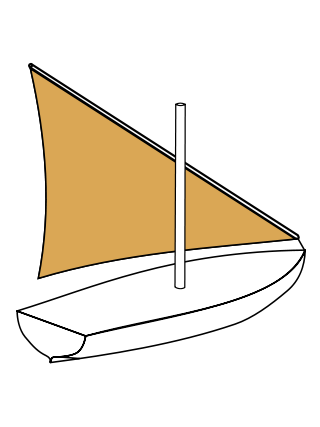
A lateen or latin-rig is a triangular sail set on a long yard mounted at an angle on the mast, and running in a fore-and-aft direction. The settee can be considered to be an associated type of the same overall category of sail.

A sewn boat is a type of wooden boat which is clinker built with its planks sewn, stitched, tied, or bound together with tendons or flexible wood, such as roots and willow branches. Sewn boat construction techniques were used in many parts of the world prior to the development of metal fasteners, and continued to be used long after that time for small boats to reduce construction costs where metal fasteners were too expensive.

A treenail, also trenail, trennel, or trunnel, is a wooden peg, pin, or dowel used to fasten pieces of wood together, especially in timber frames, covered bridges, wooden shipbuilding and boat building. It is driven into a hole bored through two pieces of structural wood.

Clinker-built is a method of boat building in which the edges of hull planks overlap each other. Where necessary in larger craft, shorter planks can be joined end to end, creating a longer strake or hull plank.

The Hjortspring boat is a vessel designed as a large canoe, from the Scandinavian Pre-Roman Iron Age. It was built circa 400–300 BC. The hull and remains were rediscovered and excavated in 1921–1922 from the bog of Hjortspring Mose on the island of Als in Sønderjylland, southern Denmark. The boat is the oldest find of a wooden plank ship in Scandinavia and it closely resembles the thousands of petroglyph images of Nordic Bronze Age ships found throughout Scandinavia. The vessel is a clinker-built wooden boat of more than 19 metres length overall, 13.6 metres long inside, and 2 metres wide. Ten thwarts that could have served as seats, span the boat with room for two persons each; this suggests space for a crew of at least 20 who propelled the boat with paddles. The boat would have weighed an estimated 530 kilograms, making it easily portable by its crew.

Traditionally, many different kinds of boats have been used as fishing boats to catch fish in the sea, or on a lake or river. Even today, many traditional fishing boats are still in use. According to the United Nations Food and Agriculture Organization (FAO), at the end of 2004, the world fishing fleet consisted of about 4 million vessels, of which 2.7 million were undecked (open) boats. While nearly all decked vessels were mechanised, only one-third of the undecked fishing boats were powered, usually with outboard engines. The remaining 1.8 million boats were traditional craft of various types, operated by sail and oars.

The Abydos boats are the remnants of a group of ancient royal Egyptian ceremonial boats found at an archaeological site in Abydos, Egypt. Discovered in 1991, excavation of the Abydos boats began in 2000 at which time fourteen boats were identified. They are located alongside the massive mudbrick structure known as Shunet El Zebib, attributed to the 2nd Dynasty Pharaoh Khasekhemwy. Shunet El Zebib is one of several such "enclosure wall" constructions at this site dating back to the 1st Dynasty, and is located nearly one mile from the early dynastic royal cemetery of Umm El Qa'ab.
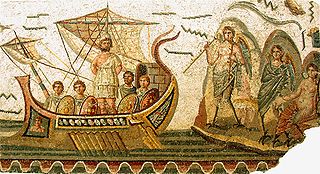
Discovered by divers from the French Navy Diving School in 1967, the archaeological investigations of the Roman wreck at Madrague de Giens constituted the first large scale, "truly scientific underwater excavation[s] carried out in France". The wreck lies at around 18 to 20 metres depth off the coast of the small fishing port of La Madrague de Giens on the Giens Peninsula, east of Toulon, on the southern Mediterranean coast of France. Sunk around 75–60 BCE, the vessel has been found to be "a large merchantman of considerable tonnage—400 tons deadweight with a displacement of around 550 tons", making it one of the largest Roman wrecks excavated, with only the wreck at Albenga, Italy exceeding it at the time of its discovery. The vessel wrecked at Madrague de Giens measured around 40 metres in length; has a "wine glass" section which would have given better ability to sail to windward; displayed extended raking of the stem and stern; and had two masts. The hull was characterised by a reverse stempost in the shape of a ram with a big cutwater which "must have given... [the] craft high-performance sailing qualities". The ship sank while transporting a large cargo of wine and black glazed pottery from Italy. It is not known why it sank.

Bangka are various native watercraft of the Philippines. It originally referred to small double-outrigger dugout canoes used in rivers and shallow coastal waters, but since the 18th century, it has expanded to include larger lashed-lug ships, with or without outriggers. Though the term used is the same throughout the Philippines, "bangka" can refer to a very diverse range of boats specific to different regions. Bangka was also spelled as banca, panca, or panga in Spanish. It is also known archaically as sakayan.
A baris is a type of ancient Egyptian ship, whose unique method of construction was described by Herodotus, writing in about 450 BC. Archeologists and historians could find no corroboration of his description until the discovery of the remains of such a ship in the waters around Thonis-Heracleion in Aboukir Bay in 2003.

Lashed-lug boats are built using a long-standing traditional boat-building technique found in Maritime Southeast Asia. It dates back at least to early in the first millennium CE and its use has continued into the 20th century. Lashed lug construction is closely associated with Austronesian maritime activity.
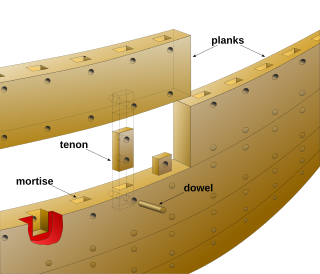
Phoenician joints is a locked mortise and tenon wood joinery technique used in shipbuilding to fasten watercraft hulls. The locked mortise and tenon technique consists of cutting a mortise, or socket, into the edges of two planks and fastening them together with a rectangular wooden knob. The assembly is then locked in place by driving a dowel through one or more holes drilled through the mortise side wall and tenon.
An itaomacip is a boat built traditionally by the Ainu for seafaring purposes. The name itaomacip is derived from the Ainu words ita-oma-cip, meaning literally a "boat with a board". It is a sewn boat enlarged via attaching side plates to a dugout canoe. When navigating inland waters, like rivers or lakes, Ainu typically utilized a cip, or plain dugout canoe, but used itaomacips whenever navigating the outer seas for trading purposes. Its construction techniques are unknown from other regions of Japan other than Hokkaido.


















